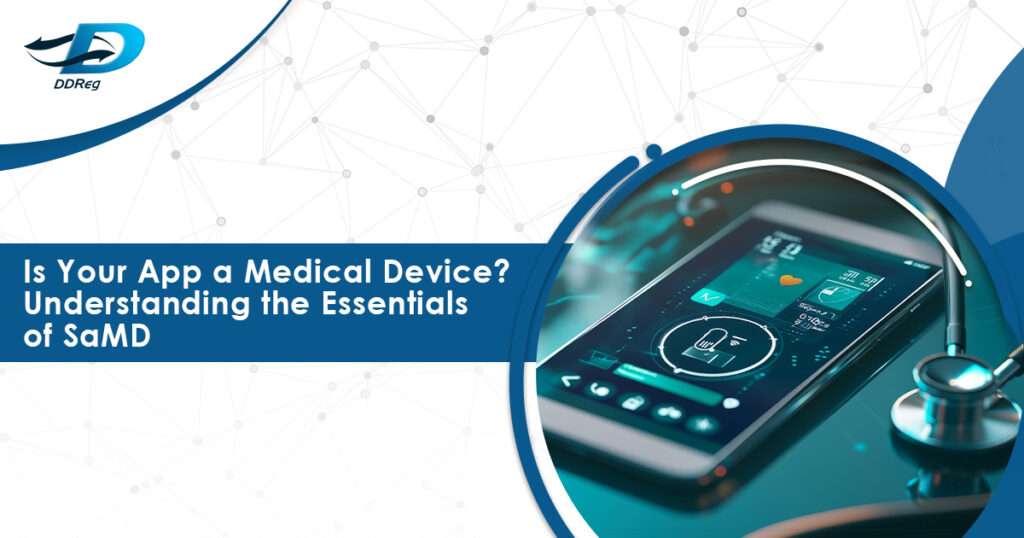
What is Software as a Medical Device?
The International Medical Device Regulators Forum (IMDRF) defined Software as a Medical Device (SaMD) as “software intended to be used for one or more medical purposes that perform these purposes without being part of a hardware medical device”. The FDA also aligns with this, noting SaMD runs on general-purpose computing platforms, such as smartphones or tablets, enhancing accessibility. SaMD is unique as it does not require specific medical devices hardware to work. Instead, it works on devices many of us already have and use daily. This distinction is important because it shapes the way these products are developed, regulated, and incorporated into health care systems.
SaMD(Software as a Medical Device) is regulated by the FDA and other international authorities to ensure its safety and effectiveness. This remains a crucial focus area for both developers and users to ensure that the technology is used responsibly and effectively – particularly, given the increasing use of machine learning technology in healthcare.
Regulatory Framework for SaMD(Software as a Medical Device)
Software as a Medical Device is subject to stringent regulatory oversight, primarily by the Food and Drug Administration (FDA) in the United States and aligned with IMDRF guidelines worldwide. The FDA’s policies place emphasis on safety and effectiveness, with specific guidance for clinical evaluation and risk categorization. The IMDRF has proposed a risk classification framework that considers both the significance of the information provided by the, SaMD and the state of the healthcare situation or condition, so that regulatory controls can be set accordingly.
Contact Now For Regulatory Services For Medical Devices
In the United States, the Food and Drug Administration (FDA) classifies fda software as a medical device products using a risk-based classification system classified as Class I, II, or III—Class I being low-risk devices and Class III representing the highest-risk category. Global efforts led by the IMDRF address harmonization of standards so that innovation can reach patients safely and as quickly as possible to the healthcare providers who need them.
Regulatory Challenges for Medical Device Software
Despite its promising benefits, SaMD faces several regulatory challenges, including rapid technological advancements, cybersecurity risks, and interoperability. Keeping up with the rapid developments in technology is one of the main challenges. Frequent updates allow software to evolve more quickly than traditional medical equipment, which go through lengthy, linear development cycles. Because of this, regulators must strike a balance between safeguarding patients and preventing innovation.
The cybersecurity of devices themselves is critical because SaMD often processes sensitive data, and for this reason, thorough protection of the data is required, as well as regular security audits. Software as a Medical Device (SaMD) also operates with other systems such as electronic health records or connected medical devices, therefore complicating interoperability.
Also Read – Post-Market Surveillance (PMS) in Medical Devices : USA & EU
However, with the application of advanced technologies and robust regulatory frameworks, many of these challenges can be effectively addressed. SaMD holds the potential to revolutionize healthcare delivery by enabling remote care, facilitating early diagnoses, and supporting personalized treatment plans. This has the potential to expedite treatment delays and help improve outcomes, especially for chronic and life-threatening conditions.
The field of Software as a Medical Device (SaMD)is also powering the incorporation of further artificial intelligence and machine learning into practice. These algorithms can scan extremely large data sets for insights, interpreting data in real time, providing health systems with advanced analytics to support clinical decisions. Its applications can also be exponentially increased through integration with wearable devices and the IoT in healthcare, giving rise to a connected ecosystem for health management.
Future Opportunities and Outlook in Software as a Medical Device (SaMD)
Despite regulatory and technological challenges, Software as a Medical Device (SaMD) holds immense potential to transform healthcare delivery. With advancements in artificial intelligence, machine learning, and wearable technologies, SaMD solutions can drive early disease detection, enable personalized treatment plans, and support continuous remote patient monitoring.
Also Read – How to Register a Medical Device in Egypt: Regulatory Pathways with the EDA
Integration with the Internet of Things (IoT) further enhances these capabilities, creating a connected healthcare ecosystem that empowers both patients and providers.
As regulatory frameworks evolve to keep pace with innovation, the SaMD landscape will likely see increased adoption, ultimately improving health outcomes worldwide.
Conclusion
In conclusion, SaMD represents a transformative advancement in healthcare—delivering software-driven solutions that offer increased accessibility, efficiency, and accuracy. Regulated under frameworks like those from the FDA and IMDRF, these solutions continue to push boundaries in remote monitoring, diagnostics, and AI-driven care. As the technology advances, understanding and navigating its regulatory landscape becomes essential for ensuring safe, timely innovation in patient care.
In addition to providing regulatory Affairs Services and pharmacovigilance services for global customers, DDReg Pharma offers specialized clinical regulatory services to assist with Clinical Trial Applications in the United States. For further information, connect with our experts. Read more about medical device regulations from the experts here: Medical Device Regulations in the United States
